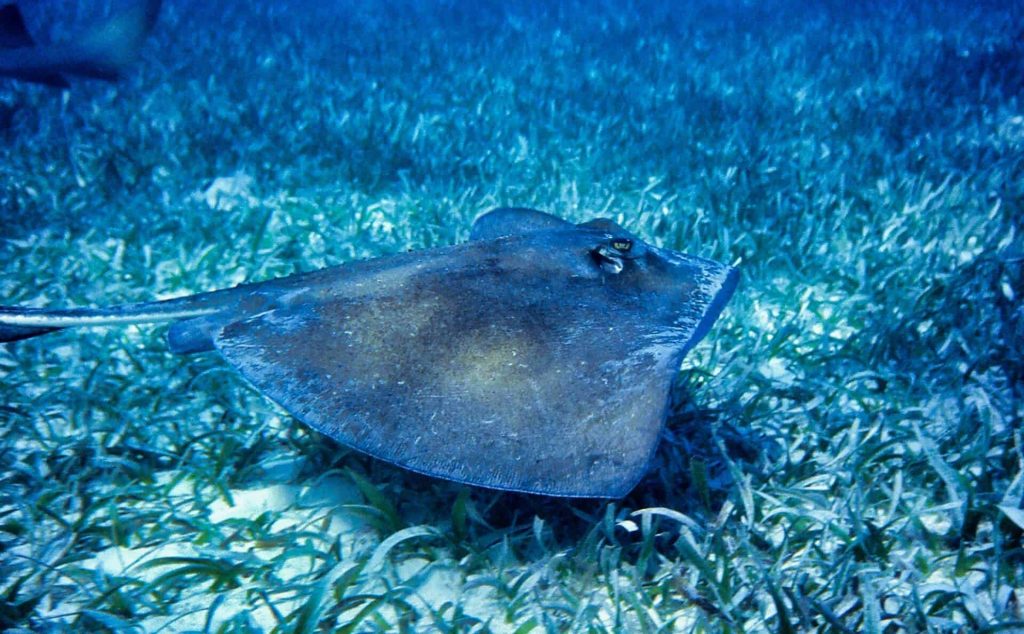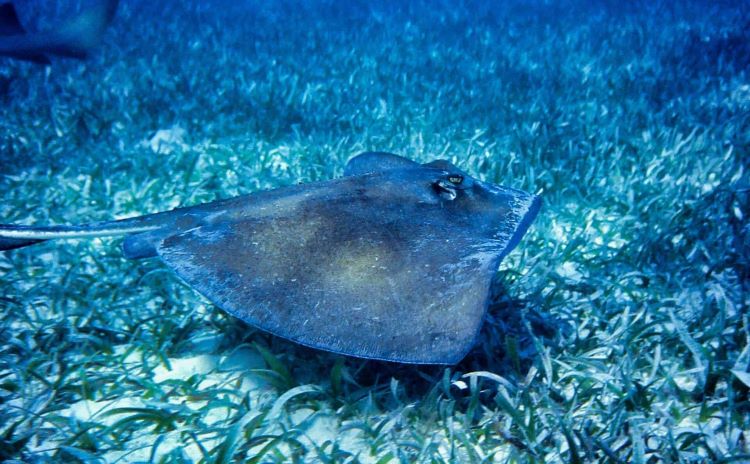Stingrays are a group of sea rays that belong to the family Dasyatidae. There are over 200 species of stingrays found in oceans and seas around the world. They are closely related to sharks and have a flattened body shape with eyes on top and a long, whiplike tail that usually contains one or more serrated, venomous spines.
Stingrays reproduce through internal fertilization, also similar to sharks. The male uses his claspers to insert sperm into the female’s cloaca. Females typically give birth to live young, known as pups, following a gestation period. The litter size, gestation length, and reproductive frequency vary between species. Some species reproduce seasonally while others can mate year-round.
Understanding stingray reproduction provides insight into their life history and behavior. Factors like breeding seasons, mating behaviors, gestation periods, and litter sizes reveal how different stingray species have adapted their reproductive strategies for survival and propagation. This piece is about Stringray’s reproduction habit.

Stingrays Mating Season
In temperate areas, stingrays mate typically in the warmer and summer months. This includes along the Atlantic coast of North America where mating season is May through July.
Stingrays mate all year-round in tropical and subtropical areas as water temperatures are consistently warm. Some species that live in these warmer waters have a peak breeding time. For example, the southern stingray in areas like the Caribbean mates in late spring between March and June.
The mating season coincides with the warmer months because stingrays are ectothermic, they rely on external temperatures to regulate their body temperature. Warmer waters help stimulate mating activity and optimize conditions for egg development. The timing ensures young are born when ample food sources are available and the water is warm.
Stingrays Mating Behavior
Stingrays employ several strategies for finding mates and breeding. Males will follow females around and initiate mating by biting and holding onto the female’s pectoral disc. This allows the male to insert one of his two claspers into the female’s cloaca to fertilize her eggs internally.
Some species form mating aggregations where large numbers of males and females gather together to breed. These temporary groups allow the stingrays to find partners more readily. The round stingray is one species known for forming dense mating aggregations of up to several hundred rays during peak breeding season.
Another technique stingrays use is pairing off into monogamous couples during breeding time. The cowtail stingray exhibits this long-term monogamous breeding behavior. Scientists have observed bonded male and female cowtails staying together for days, with the much smaller male closely following behind the larger female.
Stingrays Gestation Period
Female stingrays carry their young for quite a long time before giving birth. The gestation period, which is the length of pregnancy, can vary somewhat between stingray species but is generally several months long.
The gestation period of the Atlantic stingray is around 4 months. The southern stingray has a gestation period lasting 5 – 6 months. Other stingray species may have pregnancy lengths from 4 – 12 months.
The developing stingray pups grow inside egg cases within the female’s uterus, nourished by the egg yolk. Most species give birth to litters of 2 – 6 pups alive. The gestation period allows time for the pups to fully develop before being born. Newborn stingrays emerge from the mother ready to function and survive in their ocean environment.
The long pregnancy of stingrays contrasts with the much shorter gestation times of many other fish species, which may spawn eggs that then hatch into independent young. The longer development inside the mother’s body allows stingray pups to emerge with better developed senses, swimming ability, and survival reflexes.
Stingrays Litter Size
Stingrays typically give birth to litters of 2 – 6 pups alive at a time. The number of pups in a litter can vary significantly depending on the specific species of stingray. Some species, like the Atlantic stingray, generally have smaller litters of 2 – 4 pups. Other larger species can have litters of up to 6 or more pups.
The litter size also depends on the size and age of the mother. Older, larger female stingrays often give birth to larger litters than younger stingrays. In general, most stingrays give birth to litters of 2-6 pups at a time.
Stingrays Birth & Early Life
Stingray pups are born live after a gestation period of 4 – 6 months, though this can vary by species. Unlike most fish that lay eggs, stingrays give birth to live young.
When it’s time to give birth, the female stingray will find a quiet, sheltered area near the shore. This provides protection from predators during the vulnerable birthing process. The pups emerge one by one from the mother’s cloaca (the single opening for waste, reproduction, etc).
Newborn stingray pups are relatively small, often around 6 – 8 inches long. They emerge enveloped in an egg case or membrane, which they quickly break out of once born. The mother provides no parental care after birth. The pups are born fully developed and ready to swim off and hunt on their right away.
In the first few months of life, the stingray pups will feed on small crustaceans and grow quickly. Their venomous barbed stingers develop within the first day after birth, providing them with defense against predators. The pups will continue developing hunting skills and avoiding predators during these early months until they reach maturity.
Stingrays Sexual Maturity
Stingrays typically reach sexual maturity between 2 – 5 years old, depending on the species. Smaller species like the blue-spotted ribbontail ray reach maturity around 1 year old. Larger species like the giant freshwater stingray can take up to 5 years to reach maturity.
Once mature, male and female stingrays are able to successfully mate and reproduce offspring. Factors that influence the age of maturity include:
- Species: Small species mature faster while large species take longer.
- Environment: Stingrays in optimal conditions may mature faster.
- Nutrition: Well-fed stingrays tend to grow and mature quickly.
- Genetics: Some stingrays are genetically predisposed to mature earlier.
In addition, maturity in stingrays involves examining physical signs. Mature male stingrays develop calcified testes and claspers near the pelvic fins. Mature females develop a rounded body shape as the uterus expands. Tracking growth rates can also be estimated when a stingray reaches maturity.
Understanding when stingrays sexually mature helps scientists and aquarists manage breeding and conservation programs. By determining the age of maturity, the reproductive capabilities and lifespan of different stingray species can be better understood.
Stingrays Mating Frequency
Stingrays can reproduce multiple times over their lifespan. On average, female stingrays will give birth every 2 years after reaching sexual maturity. The frequency of breeding depends on the stingray species and conditions. Some species may breed annually, while others breed every other year.
In general, female stingrays are capable of reproducing multiple times during their lifespan once they reach sexual maturity. The gestation period for stingrays ranges from 4 – 12 months depending on the species. This allows females to breed again shortly after giving birth.
Throughout their lifetime, healthy female stingrays may produce anywhere from 5 – 25 litters. Their high reproductive potential contributes to why most stingray species are not currently threatened. However, exceptions exist for species like manta rays that only produce a single pup every 2 – 5 years.
Ultimately, the breeding frequency over a stingray’s lifespan enables stable population levels but can vary based on factors like habitat, food availability, and lifespan of the species. Proper management of stingray populations is important to prevent overfishing.
Stingrays Lifespan
Stingrays typically have relatively long lifespans compared to other fish. On average, most species live 15-25 years in the wild. Some of the larger stingray species, like the giant freshwater stingray, are thought to live upwards of 30-40 years.
The exact lifespan of a stingray depends on its species and environmental factors. Smaller species that inhabit shallow coastal waters tend to have shorter lifespans of 10-15 years. Larger pelagic species that migrate long distances in the open ocean can live 20 years or longer.
Diet, predation, habitat degradation, and fishing pressure all play a role in the average lifespan of wild stingrays. Those kept in captivity under optimal conditions may exceed their average wild lifespan. For example, captive cownose rays have been known to live for over 30 years.
Threats to Stingray Populations and Reproduction
Stingrays face several threats that endanger their populations and ability to successfully reproduce. Some of the major dangers include:
- Overfishing: Stingrays are commercially fished for their meat, skin, and cartilage. Unsustainable fishing practices have led to overharvesting and population declines in many species. This reduces the number of mature adults able to mate and reproduce.
- Habitat degradation: Stingrays rely on coastal and coral reef habitats. Pollution, development, dredging, and climate change all degrade and destroy these habitats. Loss of breeding and nursery grounds disrupts mating, gestation, and raising of young.
- Bycatch: Stingrays get caught accidentally in fishing nets and traps intended for other species. They frequently die from injuries and stress. Bycatch removes breeders from the population.
- Climate change: Rising ocean temperatures, acidification, and extreme weather events further threaten stingray habitats. This adds stress during breeding seasons and early life stages.
- Predators: Natural predators like sharks take a toll on stingray populations. But human activities have disrupted food chains, increasing predation risk for species already in decline.
Protecting critical habitats, setting catch limits, modifying fishing gear, and establishing marine preserves can help mitigate these threats. But more conservation action is urgently needed to ensure healthy, viable stingray populations for the future.
FAQs About Stringrays
What Do Stingrays Like To Eat?
Stingrays typically eat oysters, snails, clams, slugs, shrimp, and other animals that live on or beneath the sand. Stingrays also eat algae and seaweeds found within the water body.
What Time Of Day Are Stingrays Most Active?
Stingrays are most active during the afternoon when the water is warm and the tide is lower. Hunting takes place during this period.
How Do Stingrays Hunt?
Most stingray species are ambush hunters. stingrays hunt by waiting for their prey to come close, then press the prey with its pectoral fins against a wall or substrate to pull the prey underneath the body. This hunting style is called tenting.
What Is a Group Of Stingrays Called?
A group of stingrays is called a fever or a school.
How Many Species Of Stingrays Are There?
About 220 stingray species have been discovered in tropical and subtropical marine waters throughout the world. The largest species of stingray is the wild smalleye stingray.
Are Stingrays Mammals?
Stingrays are not mammals, they are cartilaginous fish. Though they give birth to their young ones alive. Another evidence to buttress that stingrays are not mammals is that they breathe with their gills underwater.
Related: Goldfish Reproduction: Breeding Frequency & Process
We hope this article provides a better insight into how Stingrays reproduce, their litter size, mating behavior, maturity, and how long they live. This a well-researched article for aquaculturists and nature enthusiasts.
